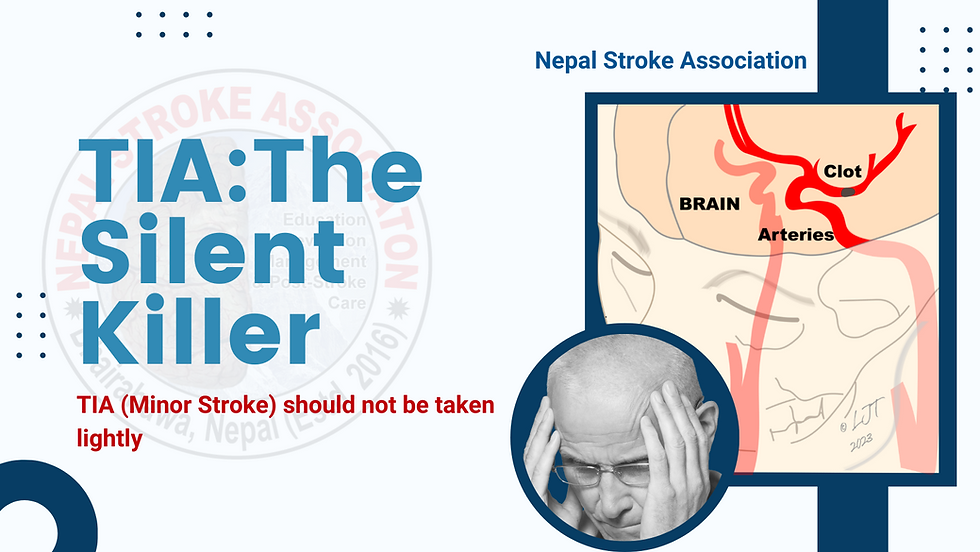TIA (Mini-stroke): The Quick Fix that Could Save Your Life
- Dr. Lekhjung Thapa, MD, DM (Neurology)

- Jan 17, 2023
- 4 min read
"The Time to Act is Now"

As a neurologist with over a decade of experience in the field of stroke, my experience with TIA (Transient Ischemic Attack) has taught me that it is a serious condition that should not be ignored. TIAs typically lasts for a short period of time, usually less than 5 minutes to a few hours and are often considered a warning sign of an impending stroke (estimates ranging from 10-30% within the first 90 days after a TIA) and have a high risk of recurrence.
"10-30% of patients suffer severe stroke within the first 90 days after a TIA (minor stroke)." – Researches
It is caused by a temporary disruption in blood flow to the brain. This disruption can occur due to a number of different factors, including:
Clot formation: A clot can form in a blood vessel leading to the brain, blocking blood flow and causing a TIA. This can occur in the carotid artery, which supplies blood to the brain, or in a blood vessel within the brain itself.
Emboli: Emboli are small clots or pieces of debris that can travel through the bloodstream and become lodged in a blood vessel leading to the brain, blocking blood flow and causing a TIA.
Arterial spasms: A sudden narrowing of an artery can occur, due to a spasm of the smooth muscle in the arterial wall. This can cause a temporary disruption in blood flow to the brain, resulting in a TIA.
Low blood pressure: A drop in blood pressure can cause a temporary reduction in blood flow to the brain, resulting in a TIA.
Hemorrhage: a bleeding in the brain can cause a TIA like symptoms.
In my practice, I have seen firsthand the devastating effects of a stroke, and I know that prompt diagnosis and treatment of TIA can help reduce the risk of a more serious stroke.
In my experience, many patients with TIA may not fully understand the gravity of their condition, and may delay seeking medical attention. I often emphasize to my patients the importance of seeking medical attention immediately if they suspect they may be experiencing a TIA, as early diagnosis and treatment can greatly improve outcomes.
"In my experience, many patients with TIA may not fully understand the gravity of their condition, and may delay seeking medical attention." – Author
Here are some tips to help treat and prevent Transient Ischemic Attack (TIA) or mini-stroke effectively.
Tip #1 - Know the acronym "FAST"
FAST is an acronym that stands for "Face, Arms, Speech, Time." It is a simple way to remember the signs of a stroke, and to act quickly if you suspect someone is having a stroke.
Tip #2 - Control your blood pressure
High blood pressure is a major risk factor for TIA and stroke, so it is important to have your blood pressure checked regularly and take steps to control it, if necessary. This can include lifestyle changes such as diet, exercise, and weight management, as well as medication as prescribed by your doctor.
Tip #3 - Manage your cholesterol
High cholesterol is another major risk factor for TIA and stroke. Eating a healthy diet low in saturated fats, exercising regularly, and taking cholesterol-lowering medication as prescribed by your doctor can help lower your cholesterol levels.
Tip #4 - Maintain a healthy lifestyle
Eating a healthy diet, getting regular physical activity, and maintaining a healthy weight can help reduce the risk of TIA and stroke.
Tip #5 - Quit smoking
Smoking increases the risk of TIA and stroke, so if you smoke, quitting is one of the best things you can do for your health.
Tip #6 - Control your diabetes
If you have diabetes, it is important to manage your blood sugar levels and keep them in a healthy range to reduce the risk of TIA and stroke.
Tip #7 - Manage Atrial fibrillation
If you have irregular pulse, also known as atrial fibrillation (AF), it's important to take steps to control it. This can include taking medication to control your heart rate and blood thinners to reduce the risk of blood clots.
Tip #8 - Avoid Heavy alcohol consumption
Heavy alcohol consumption, defined as more than 21 standard drinks per week for men and more than 14 standard drinks per week for women, is associated with an increased risk of stroke.
In conclusion,
TIA, also known as a "mini-stroke," is a serious medical condition that requires prompt attention. It is caused by a temporary disruption of blood flow to the brain and can have warning signs and symptoms similar to those of a full-blown stroke. Risk factors for TIA include high blood pressure, high cholesterol, diabetes, and smoking. It is important for individuals to be aware of the warning signs and symptoms of TIA and seek immediate medical attention if they suspect they or someone they know is experiencing a TIA. Additionally, preventative measures such as maintaining a healthy lifestyle, managing underlying medical conditions, and regular check-ups with healthcare providers can help reduce the risk of TIA. Early diagnosis and treatment can help prevent more serious complications from a TIA or full-blown stroke in the future.
What would you do if you see a 60 year-old man who had sudden onset facial drooping, arm weakness and slurring of speech but recovered within 2 minutes?
Stay at home and give him plenty of oral fluids
Take him to physiotherapy
Take him to hospital for detail evaluation
I am not sure



Excellent